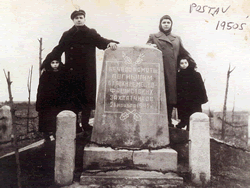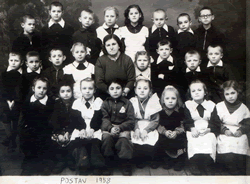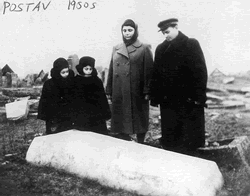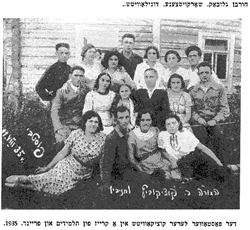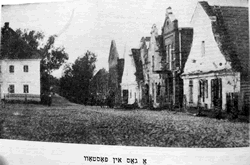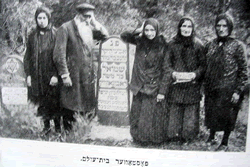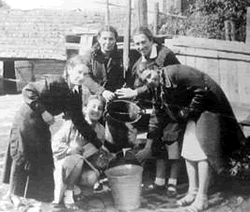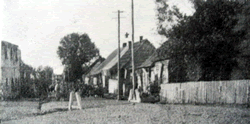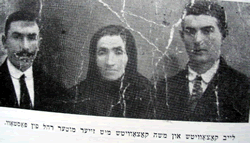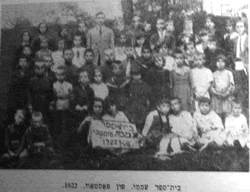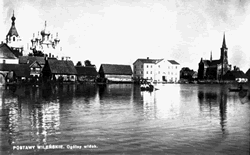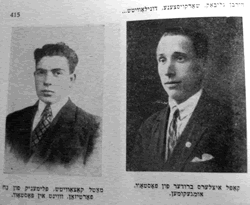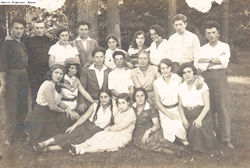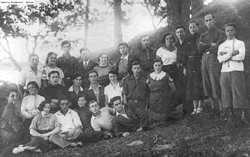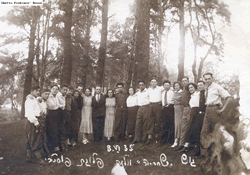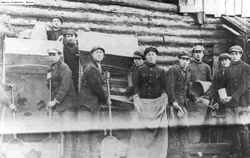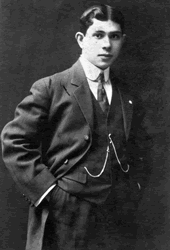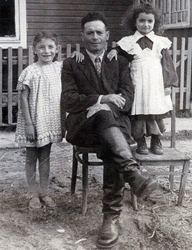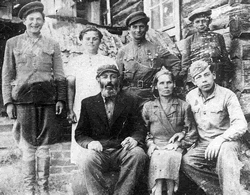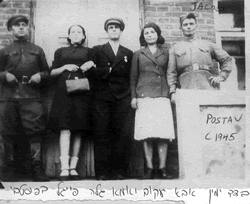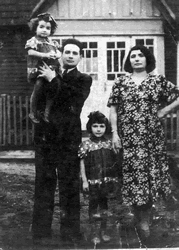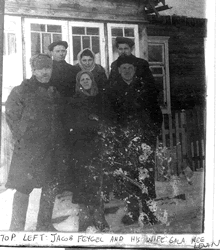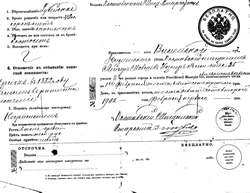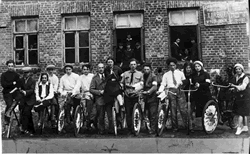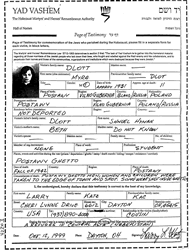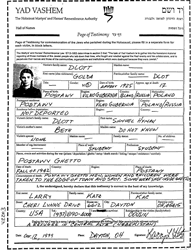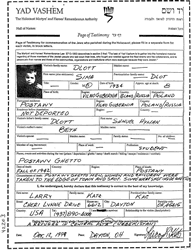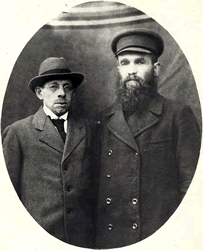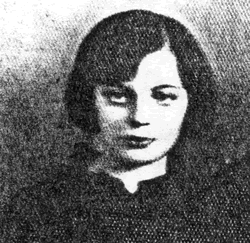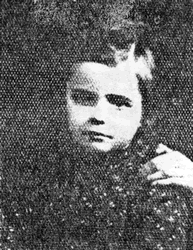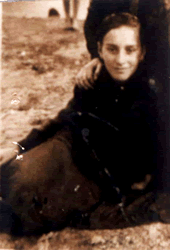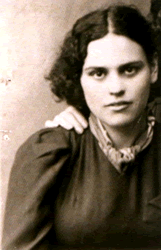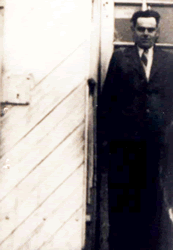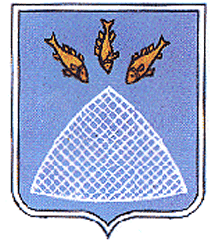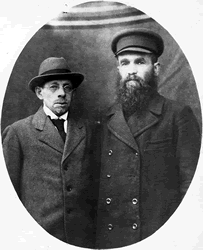Also known as PASTAVY, and POSTAWY
89.0 miles NNW of Minsk
Pastavy is the centre of the Pastavy district, Viciebsk region (Belarus), 250 km West of Viciebsk, a station on the railway line Viciebsk-Vilnius (Vilnia) in Lithuania.
Population: 23,900 (1995)
Before the first World War part of the Russian Empire, 1921- 1939 part of Poland,
1939- 1941 part of the Soviet Union, 1944 - 1990s part of the Soviet Union.
#pstv-a: |
#pstv-b: |
#pstv-c: |
|
#pstv-1: |
#pstv-2: |
#pstv-3: |
|
#pstv-4:
|
#pstv-5:A
group of girls at a well: (left to right) Sonia Strichanski, Slove
Taudrese, Ronia Pergament, Chashe Mampil, unidentified. 1938.
|
#pstv-6:
|
|
#pstv-7:
|
#pstv-8:
|
#pstv-9:
|
|
#pstv-10:R'
Zalmen & Rachel Katz from Postavy
|
#pstv-11:
|
#pstv-12:
|
#pstv-13: |
#pstv-14: |
#pstv-15: Members of the Chaluts movement's local branch in Postavy December 6, 1932. |
#pstv-16: Members of the Chaluts movement from the Zionist pioneering training commune (kibbutz hachshara) in Postavy. Photographed in 1933. Note: This pluga (unit) belonged to the movement's "Shachariya" bloc of hachsharot. |
#pstv-17: Members of the Chaluts movement from the Zionist pioneering training commune (kibbutz hachshara) in Postavy. Photographed on April 19, 1935. Note: This pluga (unit) belonged to the movement's "Shachariya" bloc of hachsharot. |
#pstv-18: Members of the He - Chaluts movement from the Zionist pioneering training commune (kibbutz hachshara) in Postavy. Photographed on June 8, 1935. |
#pstv-19: Zionist pioneering training commune (kibbutz hachshara) in Postavy, who worked as porters and laborers hauling sacks. Photographed on July 11, 1934. |
#pstv-20: Pupils of the "Tarbut" school in Postavy, with several of their teachers. Photographed on May 16, 1930, the holiday of Lag B'Omer, before they went out to the forest to celebrate. The school principal's name was Chazan (first name unknown). |
#pstv-21: Dov Ber Alperovich , aka Ber, Boris, Barnett (1885 Postawy-1952 |
#pstv-22: |
#pstv-23: |
#pstv-24: |
#pstv-25: |
#pstv-26: |
#pstv-27: |
#pstv-28: |
#pstv-29: |
#pstv-30: |
#pstv-31: my great grand-uncle, Lazar Itzler's, local shetl passport, issued by the mayor of Postov, in Feb, 1903. Tim Sherrod <tsherrod@savantsolutions.com> |
#pstv-32: From; Eight Generations of the Reichel - Raichel Family |
#pstv-33: |
#pstv-34: Khanokh Todres was born in Postov in 1914 to Notel and Mina. He was a journalist working for the paper "Folks Tzeytung" . Prior to WWII he lived in Warsaw. During the war he was in Warsaw, Poland. Khanokh perished in 1941 in Kovno |
#pstv-35: Leah Dlot was born in Postawy to Shmuel Hyman and Rivka ( daughter |
#pstv-36: Myra Dlot was born in Postawy to Shmuel Hyman and Rivka ( daughter |
#pstv-37: Golda Dlot was born in Postawy to Shmuel Hyman and Rivka ( daughter |
#pstv-38: Sima Dlot was born in Postawy to Shmuel Hyman and Rivka ( daughter |
#pstv-39: From: Ariel Blessed <ariel.blessed@gmail.com> my great-great grandfathers who |
#pstv-40: Golda Dlot was born in Postavy in 1925. She perished in the Shoah in 1942. |
#pstv-41: ?Leah Dlot was born in Postavy in 1928. She perished in 1942 |
#pstv-42: Myra Dlot was born in Postavy to Shmuel and Rivka. She perished in the holocaust. |
#pstv-43: Dlot Sima was born in Postavy in 1934 to Shmuel Hyman and Rivka Beth. She perished in 1942. |
#pstv-44: Slava Todres was born in Postawy, Poland in 1923 to Nutel and Mina. She was a teacher and single. Prior to WWII she lived in Postawy, Poland. During the war she was in Postawy, Poland. Slava was murdered in the Shoah. This information is based on a Page of Testimony ) submitted by her brother, Meir Todres |
#pstv-45: Tzipora Rabinowits nee Todres was born in Postawy, Poland in 1917 to Nutel and Mina. She was a store manager and married to Zalkind. Prior to WWII she lived in Postawy, Poland. During the war she was in Postawy, Poland. Tzipora was murdered in the Shoah. This information is based on a Page of Testimony (displayed here) submitted by her brother, Meir Todres
|
#pstv-46: Notel Todres was born in Widze, Poland in 1895 to Yosef and Musia. He was a beverage store owner and married to Mina nee Zeidel. Prior to WWII he lived in Postawy, Poland. During the war he was in Postawy, Poland. Notel was murdered in the Shoah. This information is based on a Page of Testimony (displayed here) submitted by his son, Meir Todres" |
#pstv-47: Khanokh Todres was born in Postov, Poland in 1914 to Nutel and Mina. He was a journalist and single. Prior to WWII he lived in Warsaw, Poland. During the war he |
#pstv-48: Khaia Todres was born in Postow, Poland in 1919 to Nutel and Mina. She was a seamstress and single. Prior to WWII she lived in Postow, Poland. During the war she was in Postow, Poland. Khaia was murdered in the Shoah. This information is based on a Page of Testimony submitted by her brother, Meir Todres |
#pstv-49: |
#pstv-50: |
#pstv-51: |
#pstv-52: |
#pstv-53: |
#pstv-54: |
|
|
|
Please share your comments or photos or links for posting on our Guestbook Page here: egl.comments@gmail.com
members translations of the 1850 Revision List for the shtetlach of
Bildziugi, Disna, Druya, Germanovici, Glubokoye, Golubicy, Leonpol,
Plisa, Postovy, Sharkovshina, finally Luzhek.
Translations were sent to each member
best regards,Batya Matzkin Olsen, Concord, Massachusetts USA
http://www.jewishgen.org/jgff/jgff-faq.html#q3.7
http://data.jewishgen.org/wconnect/wc.dll?jg~jgsys~jgff~~POSTAVY~BEL~ST~ALL~~
For others who research Postavy
go to;
http://www.jewishgen.org/jgff/jgffweb.htm
put; TOWN; Postavy COUNTRY; Belarus leave last name blank
SEARCH TYPE: D-M Soundex
Special for Tim Sherrod; Postavy
Postavy (in belarussian - Pastavy), now - the center of Pastavy district
in Vitebsk region (250 km from Vitebsk). 15.4 thousnad inhabitants (1974).
The first mention of Pastavy is in 1522. During 16-18th centuries Pastavy
was a part of Ashmyany Povet (Vilna voevodstvo) in the Grand Duchy of
Lithuania nad in Rech Pospolitaya (union of Grand Duchy and Polish kingdom).
This town was owned by Despat-Zyanovichy and later by famous political
leader Tythengaus. Since 1793 Pastavy - a part of Russian Empire. According
to 1847 revision Pastavy Jewish community had 551 members. The results
of famous Russian sensus of 1897 are: 2397 inhabitants in Pastavy -
1310 - Jews. During 1921-39 Pastawy was a part of Polish State, since
1939 - Soviet. In June 1941 the Nazi Germany occupied Pastavy. The town
was liberated only in 5th of July 1944. In Postawy the Nazi organized
a ghetto. 4.000 Jews were crowded in the small ghetto. In November 1942
a ghetto was destroyed. The Nazis raped women in front of their husbands,
parents and children. After this they killed all the Jews. The Jews
who hid in the houses were burned alive. A woman, her name was Wayner,
run away. The fascists seized her with 5-month baby and on her eyes
smashed him. They cut off her breasts, broke the hands and the legs,
and after it shot her. This was the tragic end of the Jewish shtetl
Pastavy.
by Alex FriedmanThe Yizkor Book DatabaseSearching for Town POSTAVY Number
of Books: 3
Original Title: Khurbn Glubok, Postawy,...Koziany
English Title: The destruction of Globokie, Postawy...Koziany
Editor: M. and Z. Rajak
Published: Buenos Aires 1956
Publisher: Former Residents' Association in Argentina
Pages: 426 Languages: Yiddish
Libraries
Brandeis University Library, Waltham, MA, United States, Call No: DS135.R93
G587 1956
Jewish Theological Seminary Library, New York, NY, United States, Call
No: DS135 R93 G55 R35
YIVO Institute for Jewish Research, New York, NY, United States, Call
No: 946146
New York Public Library, Jewish Division, New York, NY, United States,
Call No: *PXW(Glubokoye) 78-5719
YIVO Institute for Jewish Research Library, New York, NY, United States,
Call No: 3/52478
Price Library of Judaica, University of Florida, Gainesville, FL, United
States, Call No: Has book
University College London, London, , England, Call No: Has book
Florida Atlantic Univ, Boca Raton, FL, United States, Call No: DS 135
R93 G587
UCLA Research Library, Los Angeles, CA, United States, Call No: DS 135
R93 G587
Postavy, Belarus
55°07' N, 26°50' EOriginal Title: Mayn shtetl Postov
English Title: My town Postov
Editor: [By] Israel Reichel
Published: Tel Aviv 1977
Publisher: Israel Reichel
Pages: 215 Languages: Yiddish
Libraries
Bar-Ilan University, Ramat-Gan, , Israel, Call No: D47(438)
YIVO Institute for Jewish Research Library, New York, NY, United States,
Call No: /87009
University of Haifa, Haifa, , Israel, Call No: 0372954
Postavy, Belarus
55°07' N, 26°50' EOriginal Title: Postavy a siluety
English Title:
Editor: Eduard Bass
Published: Prague 1971
Publisher: Vydavatelstvi Symposium
Pages: 180 aprox. Languages: Czech
Picture of Postavi from 1930 - http://www.szukamypolski.com/gap/details.php?image_id=2247&l=english
Text and photographs by Charlotte Gerber Turner
Go to the links to see pictures and full text.
http://www.depts.drew.edu/chs/turnstry.htm
It was a METAL PRETZEL-SHAPED SIGN above a bakery door that brought me back to this area. I had visited twice before as a Soviet Jewry activist, but was not allowed by authorities to return. Before walking into that bakery, I knew that my parents had come from the area between Vilna and Minsk which at various times it had been part of Poland, Germany, Russia, or Lithuania. That was the full extent of my knowledge of Postov geography. When I walked into a bakery in Vilnius and glanced into the glass case, I instinctively knew that we were close to my parents' village. The homely looking over browned thin bagel encrusted in poppy seeds carried a message for me. They were replicas of what I knew of as Montreal bagels--distinct from the more familiar plump NY-NJ variety in that it is constructed by hand of a thin coil of dough which encircles a larger hole. Each time we would visit Canada our family returned with a precious stash of dozens of Montreal bagels. I grew up thinking that we liked Montreal bagels because they were better than New York bagels. Standing in Vilna, in the bagel bakery with the metal, pretzel-shaped sign dangling above the doorway, I realized that we liked Montreal bagles not because they were better then what a we had in New Jersey, but because they were like the ones my parents had eaten growing up. On recognizing this familiar treat, I understood that the baker at the Fairmount bagel bakery in Montreal had come from the same general area that we did. I discovered that there was a lot of Postov in me even though I was the only member of my family born in the United States. Both Shifra (My sister) and I had been entertaining Postov thoughts. She had heard of a university professor who led "roots" trips. Although his trip was not appropriate for us, it did lead us to make a decision. We decided to go as a family to Postov (or Postavy) to seek our roots--to return to the shtetl where our parents, Ethel and Philip Gerber, were born. None of us could remember our parents ever having spoken nostalgically of Postov as home. For them, Postov was connected to the world via a one-way road pointing out. Clearly, the best thing about Postov was that we were no longer there, living the limited and primitive life into which they had been born. My parents were grateful that we were well settled in a better place....
Click http://www.depts.drew.edu/chs/turnstry.htm for the rest
Turner Photo Gallery Drew University, Center for Holocaust/ Genocide Study ....IN 1985 I saw a pre-World War I map of the Vilna area. Postov was there, east of Vilna, over a river and near a large lake. A contemporary Russian map of the area showed Postavy where Postov had been, east of Vilna, over a river and near a large lake. Postavy is the Russian name of Postov. I thought that if someone had bothered to put Postov on a map, it is a place we could visit. Perhaps we should. This trip was never envisioned as a family vacation. We conceived it as a fact-finding mission. Each of us had reasons to be concerned that the close confinement of this extended trip could strain family dynamics. But Melvin Gold, my brother-in-law, was an outstanding planner. The trip was to be a pilgrimage to the places that his wife, Shifra Gold, my sister, had lived before coming to America., .......
Click for the page;
http://www.depts.drew.edu/chs/prep.htm http://www.depts.drew.edu/chs/story.htm Postov: One Way--Do Not Enter
We approached Postov. I tried to imagine how Postov would look. No images surfaced. Now anxious, I wondered why I thought that this pilgrimage would be a good idea. Postov was the place our family had left. Were we returning to a place which we would be best off leaving behind? Our road passed through other villages. We glared tensely through the car windows. None of us could speak. Many thoughts preoccupied our minds. We were each engaged in dialogue with our expectations. There were no guidebooks. We depended upon Shifra to be our guide to the sights of Postov. She felt a heavy responsibility for she had instigated this pilgrimage. No one we knew had gone back to Postov. Shifra felt increasing anxiety that she would be called upon to supply information from memory that she didn't have. She reminded us that she was returning to a town which had inevitably changed vastly since she had left it in 1939. Even Postov should have changed in these 54 years. Her memories were that of an eleven-year-old child with only vague recollections. She did not want us to be disappointed. We were surprised by a civil sign that announced that we were arriving in Postov, the road funneled on to a small iron bridge which emptied into the center of our village. The first we saw of Postov was a "Do Not Enter" sign positioned in front of the town square. Shifra remembered how peasants would bring their crops and wares to market twice a week. It had undergone some renovation and now formed a park and war memorial, complete with an impressive statue of Lenin. This dominating figure remains erect in Postov even though we saw bare pedestals in other cities where statues of Lenin had been recently removed. Clearly, in the present post-U.S.S.R. world, Postov is not on the cutting edge of political change.[Editors Note: Charlotte's story continues through a series of 14 photographs with captions
http://www.depts.drew.edu/chs/story.htm Shifra is my half-sister. Her mother died in 1930 when she was four years old. Her earliest memory was of following her mother's casket to the cemetery and counting the cobblestones beneath her feet. She left Utyan in 1937 to join our father in America. Before she left, her family took a photograph. In it, she posed next to her mother's gravestone with a photograph of her mother tied onto the stone. This was intended to show Dad that the money he sent has well spent on an elegant tomb marker in memory of his disceased wife. Shifra arrived in New Jersey bearing that photograph along with a photo of her and her best girlfriends from school. Years later, she would repeatedly look at this photograph to be reminded that only she had survived to become an adult and a mother. http://www.depts.drew.edu/chs/tgallery1/tgallery1.htm The Postov town square was the military front for a short time during World War I. Trenches were dug and mortars mounted. My mother had talked of this hard time when the residents had fled for their safety, and how they starved while roaming the countryside seeking shelter and food. She remembered eating mortar
from between bricks. We have postcards which show the town square at that time. In one postcard can be seen the battle-scarred remnant of an onion-domed Russian Orthodox church. Today it stands there, pristinely restored. http://www.depts.drew.edu/chs/tgallery1/tgallery1.htm
We found ourselves in the courtyard of the Chor (Choir) Synagogue where Uncle Chaim had attended services as a Yeshiva boy. I could imagine the rich cantorial melodies that attracted him to this once famous synagogue. We read the quote etched on the doorpost under which Chaim had passed as a young Yeshiva student, "Because my house is a house of prayer to all the nations...." Now, where there had been lively worship, music and learning, this house remains silent. It is a unique building in a city that held ninety-five synagogues. It is a quiet tomb without chants or mourners. Before the slaughter, it had been one of thousands of houses of Jewish prayer, in a country alive with Jewish culture, learning and political diversity. The Chor Synagogue is now a silent museum
http://www.depts.drew.edu/chs/tgallery1/tgallery1.htm Here was the shell of a building which had been a gristmill owned by a Jewish family. http://www.depts.drew.edu/chs/tgallery1/tgallery1.htm Next to the mill was the Blind River. This name confused me when I heard mention of it as a child. My mother had described the fun that she used to have during the winter months when she and other teenagers would ice skate to the next town. I never asked how a river could be blind. The mill was located not on a river, as one would expect, but rather on a shunt which led to a man-made lake. The Blind River both started and ended at lakes giving it no access to a larger waterway. The river in Postov was blind because it led nowhere. http://www.depts.drew.edu/chs/tgallery1/tgallery1.htm
Our new acquaintance graciously answered our many questions. Yes, there had been Jews in Postov. Only one person was left who had lived there before World War II. He was a friend. She would phone him to come over. Would we like to come in? The phone call took place in Russian, which I don't understand. I heard, "...Gendel. Gendel... Gendel... Gendel." I was confused. How did she know that my mother's family name was Gendel? Our translator, Amelia, set me straight. The name of the Jewish man to whom she spoke was Gendel. He would be coming shortly. I was perplexed. How could he have my mother's name?
http://www.depts.drew.edu/chs/tgallery1/tgallery1.htm
The wait seemed longer than it was. Yes, his name was Gendel, Schner Gendel. He knew our family. It is his family as well. He is our fourth cousin once removed. His father's brother had been an apprentice to my grandfather, Shalom Gendel, the blacksmith. He also knew my father's family, but not well. Abrosheke Zuckerman, my cousin (my father's sister's son), had been his age. Shifra wanted to know how Schner had survived. Abrosheke had been greatly looked up to by a younger Shifra. She wondered over and over why Schner survived and Abrosheke, at the age of 16, had gone to his death with his grandparents, parents and younger sister. Yes, he knew what had happened to them. He would take us to the place and tell us the story. He would show us around.
http://www.depts.drew.edu/chs/tgallery1/tgallery1.htm Schner took us to my mother's family house. We were surprised to find it still standing, and we were equally surprised that Schner knew where it was. We felt fortunate to have serendipitously come across this man. Since mother's father had been a blacksmith, the house was situated on the outskirts of town. There, the sparks from the forge wouldn't have been a threat to the town's wooden homes
http://www.depts.drew.edu/chs/tgallery1/tgallery1.htm
Shifra wanted to know how Schner survived when no one in our family did. He said that he had wanted to live and didlive because of Grandfather's house.In 1942, he explained, there was a ghetto in Postov for the local Jews and for those from surrounding towns. People were brought from as far away as Bialystok. They had had to leave their homes and live in the crowded ghetto, but could go in and out of it freely. One day Schner awoke to find the ghetto surrounded by soldiers. He sensed that if he didn't escape then, he never would. And so he paid a visit to my grandfather's house ...... http://www.depts.drew.edu/chs/tgallery1/tgallery1.htm
The house was the last one in the ghetto and located on the outskirts of the village. On the adjacent lot was a shack. Schner, as others had, entered my grandfather's house through the front door and left it out through a side window which led to the shack next door. With the cover of darkness he then escaped to freedom. On that very day, everyone in the Postov ghetto, about 1,000 people were taken to the edge of a pit and shot ..... http://www.depts.drew.edu/chs/tgallery1/tgallery1.htm
When the war was over, returning Jews found scattered human bones under bushes and next to the roads. The returning men and women gathered these bones into two mass graves and encircled the area with broken gravestone fragments from the desecrated Jewish cemetery. We found deep red alpine strawberries growing wild in another area of this yard. When my son Gideon stooped to pick one, he found a spine bone planted in the soil. A watching survivor said to him, "That berry, it is painted with the blood or our ancestors."
http://www.depts.drew.edu/chs/tgallery1/tgallery1.htm .....In 1995 Postov was free of Jews. The five remaining families left that wretched place. Schner Gendel was comfortably settled in the north of Israel, with his family (pictured above with us during our visit).Shifra and I are now in touch with a network of people who emigrated after our family. We learned more of our background and were elated to learn that two of Shifra's friends who were in the photograph of her classmates that she brought to America (mentioned on page 4) had indeed survived to adulthood and had also become grandparents. One now lives in California and the other woman resides in Tel Aviv. Remarkably, for many years she has been a neighbor and friend of the family into which Shifra's daughter married......... http://www.depts.drew.edu/chs/tgallery1/tgallery1.htm
A portrait of two of my great-great grandfathers who lived near each
other in Postov. They got together to take this portrait to send to
their children on the occasion of their marriage who lived in New York
City. This photograph was most likely the last their children ever saw
of their fathers, who never left "the old country" in their lives. In
the picture, the man on the left is Louis Riback and the man on the
right is Shimon "Simon" Reichel. Louis' son Harry Riback married
Shimon's daughter Bertha Reichel and they were my great-grandparents.
Ariel. Blessed (@gmail.com)
Holocaust survivors from Postavy
From: Ruth & Bruce Lynn <lynn33@rcn.com>
Date: Sun, Jan 13, 2019 at 12:50 PM
Subject: FEIGEL family from Postavy
To: <egl.comments@gmail.com>
I just happened across your website, and it’s very impressive.
My husband’s grandmother, Ida (Chaia Gittel) FEIGEL (changed to FOGEL in the US) LIN (changed to LYNN in the US), came from Postavy, Riga, and Vilna. She was born in Postavy. They emigrated to the Chicago area.
Her father’s name was Isaac/Isaak/Yitzchak/Itzhak or possibly Aizik FEIGEL, and his wife was Sarah. He was born in Vilna or Riga.
Her brothers were Henach/Henry, Leo/Labl, and Josef. I’m not sure whether they were born in Vilna, Riga, or Postavy. Henry emigrated to Chicago.
Please let me know if any of these names sound familiar.
Thanks.
Ruth Nadelman Lynn
Lexington, MA
